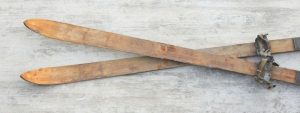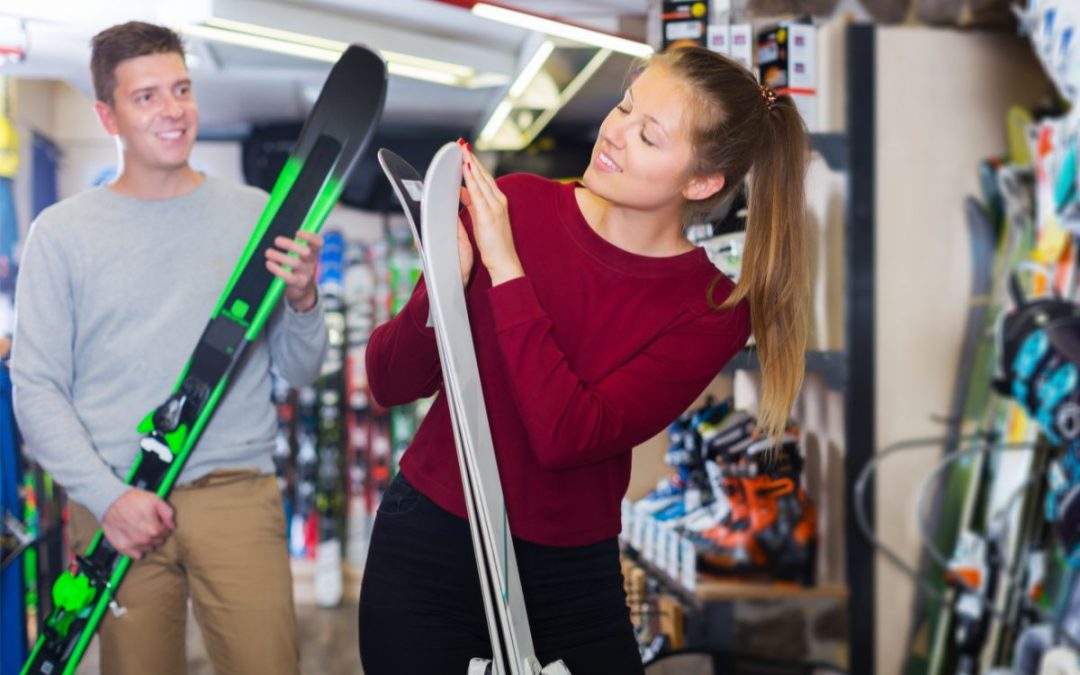If owning your own pair of skis is on your wish list this year (or you want to fulfill an item on a loved one’s wish list), you should consider the many benefits of buying used skis. But going into this purchase without knowing what to look for is much like venturing onto a black diamond slope when your experience dictates a trip to the bunny hill – if you don’t know what you are looking for, you risk buying used skis that are not worth the snow they slide on.
This month we give you everything you need to know before buying secondhand alpine (or downhill) skis.
What to Look for When Buying Used Skis
Before we get ahead of ourselves, there are four parts of a used snow ski that we will be looking at in this article. These are the key elements of a ski that affect performance and value. These are:
- Edge: This is the metal strip mounted to the sides of the ski. The condition and shape of the edge significantly affect the ski’s performance.
- Base: The bottom area of the ski that rides on the snow. The base condition is vital to ski performance.
- Top Layer: Also known as the top sheet or ski cap, this is where the bindings are mounted and where your feet attach to the ski.
- Bindings: These mechanical devices hold the boot to the ski. When buying used skis, the bindings are usually mounted on and included with the purchase.
Now that you know the lingo, let’s take a look at each part individually.
Interested in Snowboarding? Check out What to Know Before Buying Your First Snowboard

Edge
When buying used skis, you cannot rely on the age of the equipment alone. The first thing to check is that the edges are well-maintained.
- Visually check the ski edge for sharpness and no rust. Feel for ridges, gouges, and sharpness by running your fingernail along the edge carefully. The ski edges should be straight and without any bulges, dents or gaps, and should not be loose.
- The ski edges should be straight. Give the edge an eyeball test as if you were sighting a rifle or inspecting a pool cue. Don’t buy used skis that appear twisted or with edges that contain bulges, dents, gaps or looseness.
- How much edge is left on the ski? The process of tuning a ski includes grinding off a little bit of edge each time. If the skis have been tuned a lot the edges may get too thin and limit the amount of future tuning you can perform.
- See if the edges are the same thickness. If one edge is thinner than the other this could be a sign that the ski with the thinner edge has been previously damaged or skied more than the other ski.
If the edges seem to be in good shape, move to the second area, the base of the ski.
Base
One of the keys to a ski’s performance is the condition of the base. Since the base is the area that comes into contact with the snow, getting scratches and gouges from rough and hard objects such as rocks is common. Minor scratches and gouges can be easily remedied, so long as they are small, short, and not deep.
However, gouges close to the edge or a deep gouge that goes all the way to the core of the ski is a sign that you should pass on the pair. Once water reaches the core, the inevitable freeze and thaw cycle that happens every time you hit the slopes will weaken the ski and compromise the structural integrity.
Here’s an easy way to ensure the base is in good shape. Place the two skis base-to-base and slide past each other sideways. The smoother the skis against one another the better.
Related: Learn to Ski This Winter With These Tips
Top Sheet
When buying used skis, minor scratches and chips on the top sheet are to be expected. But, like the base, you want to avoid secondhand skis that have deep gouges, especially if they reach the ski’s core.
Another sign that you should look for another pair of skis is whether there is delamination (separation of layers) on the top sheet.
Here are the specific areas to check:
- Closely scan the length of the top sheet for delamination at the edges.
- Look closely around the tail (back end) of the ski for delamination caused by pounding the skis into the snow during breaks on the slopes of Colorado.
- The tip (front end) and the binding area of the ski may also have signs of delamination.
If you notice a separation in any of these areas, move on.
Bindings
Unlike a new ski purchase where ski bindings are purchased separately, the bindings are almost always included when buying used skis because the skis already have bindings attached. There are several factors to consider regarding the state of the bindings on the skis you are considering purchasing.
First, each year the major ski binding manufacturers distribute a list of indemnified bindings – which means the bindings on the list are still considered safe. Older binding models fall off the end of the list. Your goal is to buy used skis with bindings that can be serviced if needed.
Once you have ensured that the bindings are on the indemnified list, start to examine the binding itself. Start by looking for loose parts, cracks, or loose mounting screws.
Examine the front and rear DIN (spring) settings are the same. Different settings may indicate that one spring has worn out and releases too easily – not something you want to happen while you are on the slopes.
Only Buy From A Trusted Seller
 Buying used skis is a great way for Colorado mountain sports enthusiasts to save money on high-quality skis.
Buying used skis is a great way for Colorado mountain sports enthusiasts to save money on high-quality skis.
But while you may luck out and find an amazing deal on a great pair of skis on CraigsList or Facebook Marketplace, there are good reasons why you should only buy secondhand skis from a trusted source like MER.
First and foremost, as Colorado Springs leader in outdoor gear consignment, MER has strict quality standards for every piece of equipment we consign. We do not accept any skis, ski boots, poles, helmets, or other ski gear without first putting them through a rigorous inspection.
This inspection includes checking the bindings against the latest indemnification list, something that only retailers have access to.
Finally, when you are buying used skis from MER, you are ready to go. We give each pair of skis a thorough tune-up before they reach our salesfloor, including a machine buff wax, sharpening, and belt sand base. You will be swooshing down the slopes as soon as your car can carry you to the resort.
Ready to Hit the Slopes? MER Has the Gear Get You Going!
The ski season is finally here, and if you are itching to hit the slopes but need the gear to get you there, stop by MER in Colorado Springs. From skis to boots and gloves to helmets, our outdoor gear consignment shop is the best place on the Front Range to find high-quality equipment for Colorado’s winter mountain sports.
Lots to Do. MER Gets You Going.

